The Multi-Gas Sensor for Remote UAV and UGV Missions—Development and Tests
Abstract
:1. Introduction
2. Materials and Methods
2.1. Chemicals
2.2. Instrument Description
2.3. Measurement Chamber
2.4. Operation Principle
2.5. The Gas Intake System
3. Results and Discussion
3.1. Development of the ChemDet Sensor
3.2. Laboratory Tests of the Sensor
3.3. Sensor Field Tests
3.3.1. UGV Chemical Detection
3.3.2. Airborne Chemical Detection on UAVs
- For downwash testing, the DJI Inspire 2, Shenzhen, China was used [29].
4. Conclusions
4.1. Limitations of the Study
4.2. Future Work
Author Contributions
Funding
Institutional Review Board Statement
Informed Consent Statement
Data Availability Statement
Conflicts of Interest
References
- Burgués, J.; Marco, S. Environmental chemical sensing using small drones: A review. Sci. Total Environ. 2020, 748, 141172. [Google Scholar] [CrossRef]
- Waharte, S.; Trigoni, N. Supporting search and rescue operations with UAVs. In Proceedings of the EST 2010-2010 International Conference on Emerging Security Technologies, ROBOSEC 2010-Robots and Security. LAB-RS 2010-Learning and Adaptive Behaviors for Robotic Systems, Canterbury, UK, 14 October 2010; pp. 142–147. [Google Scholar] [CrossRef]
- Costo, S.; Molfino, R. A New Robotic Unit for Onboard Airplanes Bomb Disposal. In Proceedings of the 35th International Symposium on Robotics ISR 2004, Paris, France, 23–26 March 2004. [Google Scholar]
- Kaliszewski, M.; Włodarski, M.; Młyńczak, J.; Leśkiewicz, M.; Bombalska, A.; Mularczyk-Oliwa, M.; Kwaśny, M.; Buliński, D.; Kopczyński, K. A new real-time bio-aerosol fluorescence detector based on semiconductor CW excitation UV laser. J. Aerosol Sci. 2016, 100, 14–25. [Google Scholar] [CrossRef]
- Soldan, S.; Bonow, G.; Kroll, A. RoboGasInspector—A mobile robotic system for remote leak sensing and localization in large industrial environments: Overview and first results. IFAC Proc. Vol. 2012, 1, 33–38. [Google Scholar] [CrossRef]
- Measure—A 32 advisors company and American Red Cross. Drones for Disaster Response and Relief Operations. Available online: https://www.issuelab.org/resources/21683/21683.pdf (accessed on 2 November 2021).
- Witayangkurn, A.; Nagai, M.; Honda, K.; Dailey, M.; Shibasaki, R. Real-Time Monitoring System Using Unmanned Aerial Vehicle Integrated with Sensor Observation Service. Int. Arch. Photogramm. Remote Sens. Spat. Inf. Sci. 2012, 38, 107–112. [Google Scholar] [CrossRef] [Green Version]
- Ahlawat, A.; Mishra, S.K.; Gumber, S.; Goel, V.; Sharma, C.; Wiedensohler, A. Performance evaluation of light weight gas sensor system suitable for airborne applications against co-location gas analysers over Delhi. Sci. Total Environ. 2019, 697, 134016. [Google Scholar] [CrossRef] [PubMed]
- Chan, K.; Schillereff, D.N.; Baas, A.C.W.; Chadwick, M.A.; Main, B.; Mulligan, M.; O’Shea, F.T.; Pearce, R.; Smith, T.E.L.; Van Soesbergen, A.; et al. Low-Cost Electronic Sensors for Environmental Research: Pitfalls and Opportunities. Prog. Phys. Geogr. 2021, 45, 305–338. [Google Scholar] [CrossRef]
- Kuuluvainen, H.; Poikkimäki, M.; Järvinen, A.; Kuula, J.; Irjala, M.; Dal Maso, M.; Keskinen, J.; Timonen, H.; Niemi, J.V.; Rönkkö, T. Vertical profiles of lung deposited surface area concentration of particulate matter measured with a drone in a street canyon. Environ. Pollut. 2018, 241, 96–105. [Google Scholar] [CrossRef] [PubMed]
- Scentroid. Available online: https://scentroid.com/products/analyzers/dr1000-flying-lab/ (accessed on 2 November 2021).
- Teledyne FLIR. Integrated Multi-Gas Detector for Unmanned Aerial System—MUVE C360. Available online: https://www.flir.eu/products/muve-c360/ (accessed on 2 November 2021).
- Rakha, T.; Gorodetsky, A. Review of Unmanned Aerial System (UAS) applications in the built environment: Towards automated building inspection procedures using drones. Autom. Constr. 2018, 93, 252–264. [Google Scholar] [CrossRef]
- Khaloo, A.; Lattanzi, D.; Jachimowicz, A.; Devaney, C. Utilizing UAV and 3D computer vision for visual inspection of a large gravity dam. Front. Built Environ. 2018, 4, 1–16. [Google Scholar] [CrossRef] [Green Version]
- Villa, T.; Gonzalez, F.; Miljevic, B.; Ristovski, Z.D.; Morawska, L. An overview of small unmanned aerial vehicles for air quality measurements: Present applications and future prospectives. Sensors 2016, 16, 1072. [Google Scholar] [CrossRef] [PubMed] [Green Version]
- Li, C.; Han, W.; Peng, M.; Zhang, M.; Yao, X.; Liu, W.; Wang, T. An unmanned aerial vehicle-based gas sampling system for analyzing CO2 and atmospheric particulate matter in laboratory. Sensors 2020, 20, 1051. [Google Scholar] [CrossRef] [Green Version]
- Amici, S.; Turci, M.; Giulietti, F.; Giammanco, S.; Buongiorno, M.F.; La Spina, A.; Spampinato, L. Volcanic Environments Monitoring by Drones Mud Volcano Case Study. Int. Arch. Photogramm. Remote Sens. Spat. Inf. Sci. 2013, 40, 5–10. [Google Scholar] [CrossRef] [Green Version]
- Castro, A.; Magnezi, N.; Sintayehu, B.; Quinto, A.; Abshire, P. Odor Source Localization on a Nano Quadcopter. In Proceedings of the 2018 IEEE Biomedical Circuits and Systems Conference, BioCAS 2018-Proceedings, Cleveland, OH, USA, 17–19 October 2018. [Google Scholar]
- Burgués, J.; Esclapez, M.D.; Domate, S.; Pastor, L.; Marco, S. Aerial mapping of odorous gases in a wastewater treatment plant using a small drone. Remote Sens. 2021, 13, 1757. [Google Scholar] [CrossRef]
- Golston, L.M.; Aubut, N.F.; Frish, M.B.; Yang, S.; Talbot, R.W.; Gretencord, C.; McSpiritt, J.; Zondlo, M.A. Natural gas fugitive leak detection using an unmanned aerial vehicle: Localization and quantification of emission rate. Atmosphere 2018, 9, 333. [Google Scholar] [CrossRef] [Green Version]
- Pochwała, S.; Gardecki, A.; Lewandowski, P.; Somogyi, V.; Anweiler, S. Developing of low-cost air pollution sensor—Measurements with the unmanned aerial vehicles in Poland. Sensors 2020, 20, 3582. [Google Scholar] [CrossRef]
- Marwence, R.; Munniks, S.; Valente, J. Calibration of Electrochemical Sensors for Nitrogen Dioxide Gas Detection Using Unmanned Aerial Vehicles. Sensors 2020, 20, 7332. [Google Scholar] [CrossRef]
- Stix, J.; De Moor, J.M.; Rüdiger, J.; Alan, A.; Corrales, E.; D’Arcy, F.; Diaz, J.A.; Liotta, M. Using Drones and Miniaturized Instrumentation to Study Degassing at Turrialba and Masaya Volcanoes, Central America. J. Geophys. Res. Solid Earth 2018, 123, 6501–6520. [Google Scholar] [CrossRef]
- Crazzolara, C.; Ebner, M.; Platis, A.; Miranda, T.; Bange, J.; Junginger, A. A new multicopter-based unmanned aerial system for pollen and spores collection in the atmospheric boundary layer. Atmos. Meas. Tech. 2019, 12, 1581–1598. [Google Scholar] [CrossRef] [Green Version]
- DJI. What’s That Smell? This Gas-Sniffing Drone Sensor Can Tell. Available online: https://dronedj.com/2020/08/18/sniffing-drone-measures-air-quality/ (accessed on 5 November 2021).
- Ammonia Gas Sensor NH3/SR-200 Specification Sheet; Membrapor AG: Wallisellen, Switzerland, 2020; pp. 1–4.
- Zaidi, N.A.; Tahir, M.W.; Vellekoop, M.J.; Lang, W. A gas chromatographic system for the detection of ethylene gas using ambient air as a carrier gas. Sensors 2017, 17, 2283. [Google Scholar] [CrossRef] [Green Version]
- Taurob. Home Page. Available online: https://taurob.com/ (accessed on 5 November 2021).
- DJI. Inspire 2 Specifications. Available online: https://www.dji.com/uk/inspire-2/info#specs (accessed on 5 November 2021).
- DJI. M600 Specifications. Available online: https://www.dji.com/uk/matrice600-pro/info#specs (accessed on 5 November 2021).
- Brinkman, J.L.; Davis, B.; Johnson, C.E. Post-movement stabilization time for the downwash region of a 6-rotor UAV for remote gas monitoring. Heliyon 2020, 6, e04994. [Google Scholar] [CrossRef]
- Sarghini, F.; De Vivo, A. Interference analysis of an heavy lift multirotor drone flow field and transported spraying system. Chem. Eng. Trans. 2017, 58, 631–636. [Google Scholar] [CrossRef]
- Burgués, J.; Hernández, V.; Lilienthal, A.J.; Marco, S. Smelling nano aerial vehicle for gas source localization and mapping. Sensors 2019, 19, 478. [Google Scholar] [CrossRef] [PubMed] [Green Version]
- Dmitrzak, M.; Jasinski, P.; Jasinski, G. Limited selectivity of amperometric gas sensors operating in multicomponent gas mixtures and methods of selectivity improvement. Bull. Pol. Acad. Sci. Tech. Sci. 2020, 68, 1275–1282. [Google Scholar] [CrossRef]


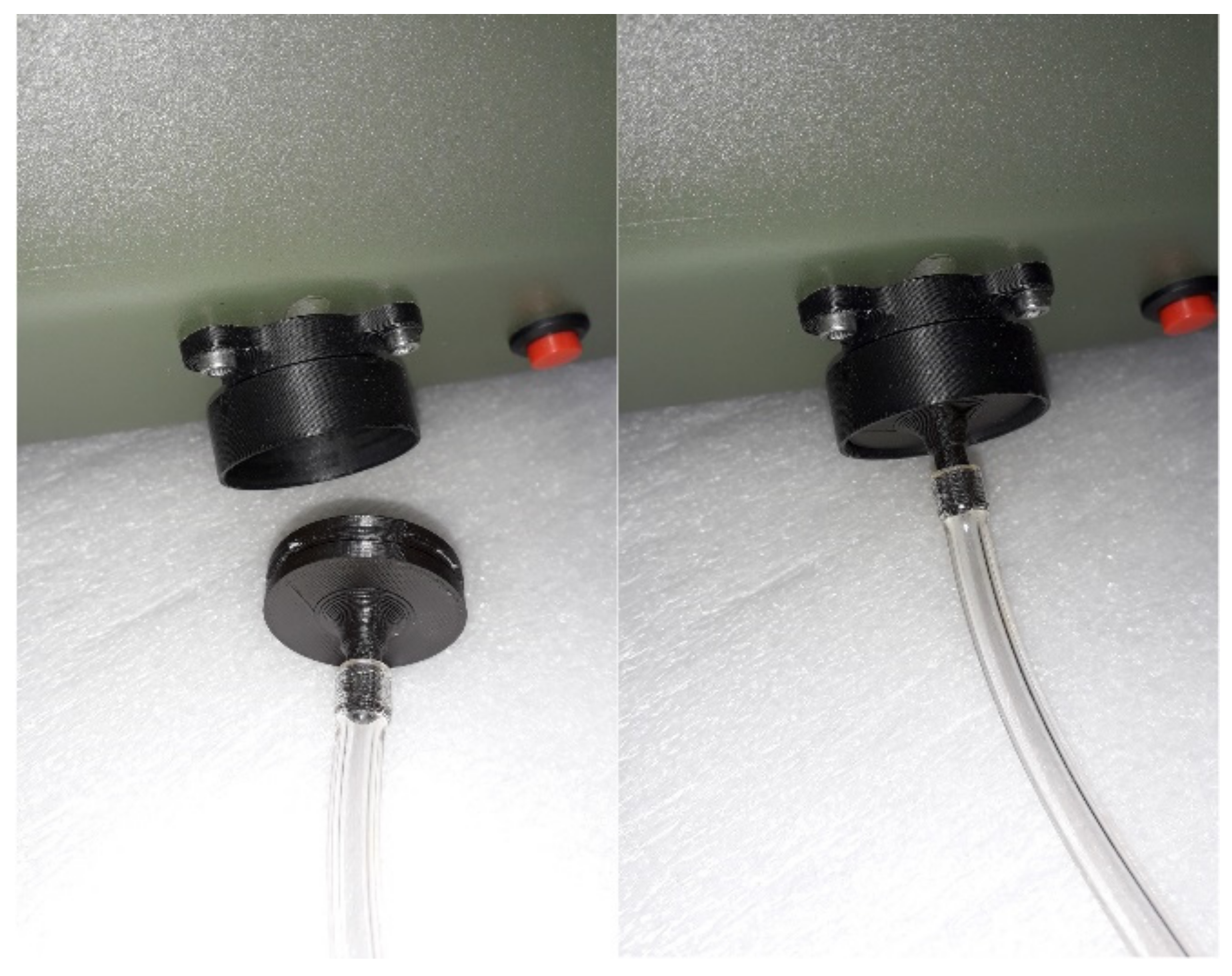
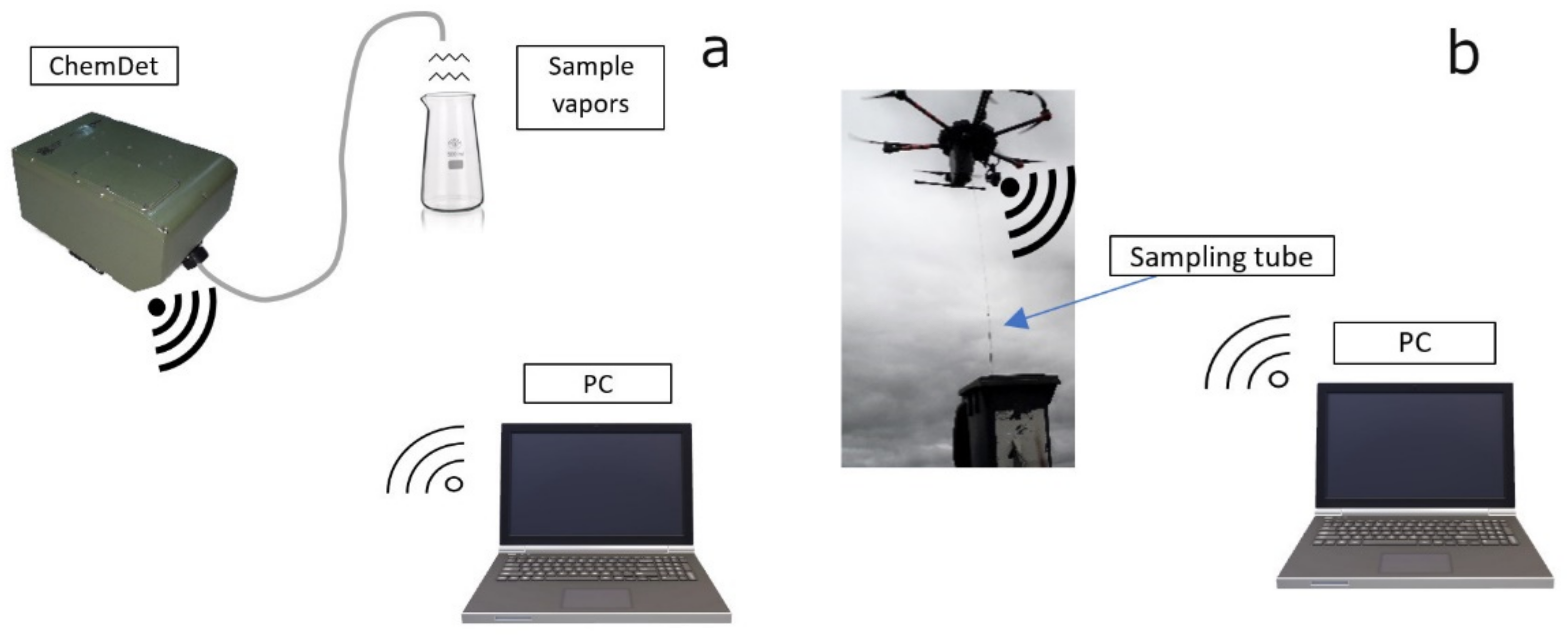

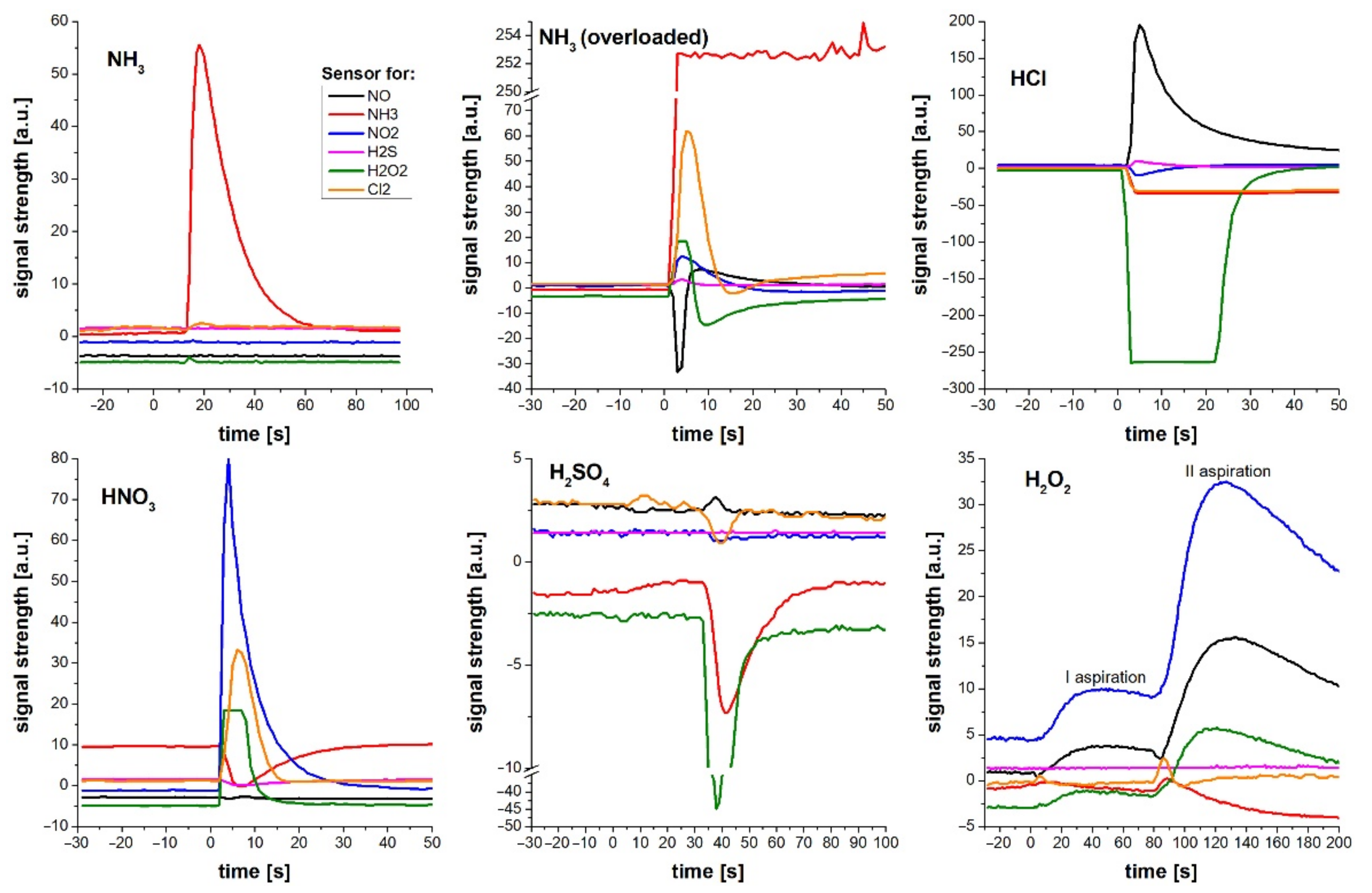
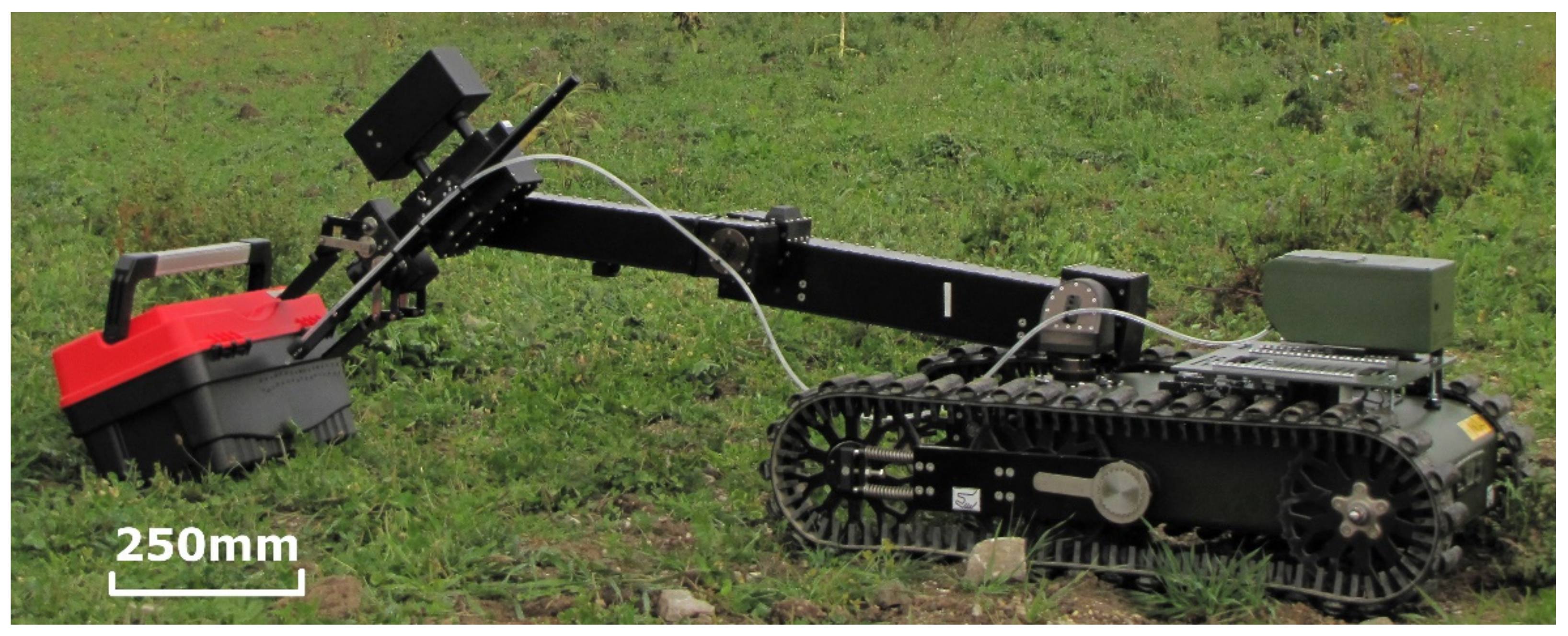
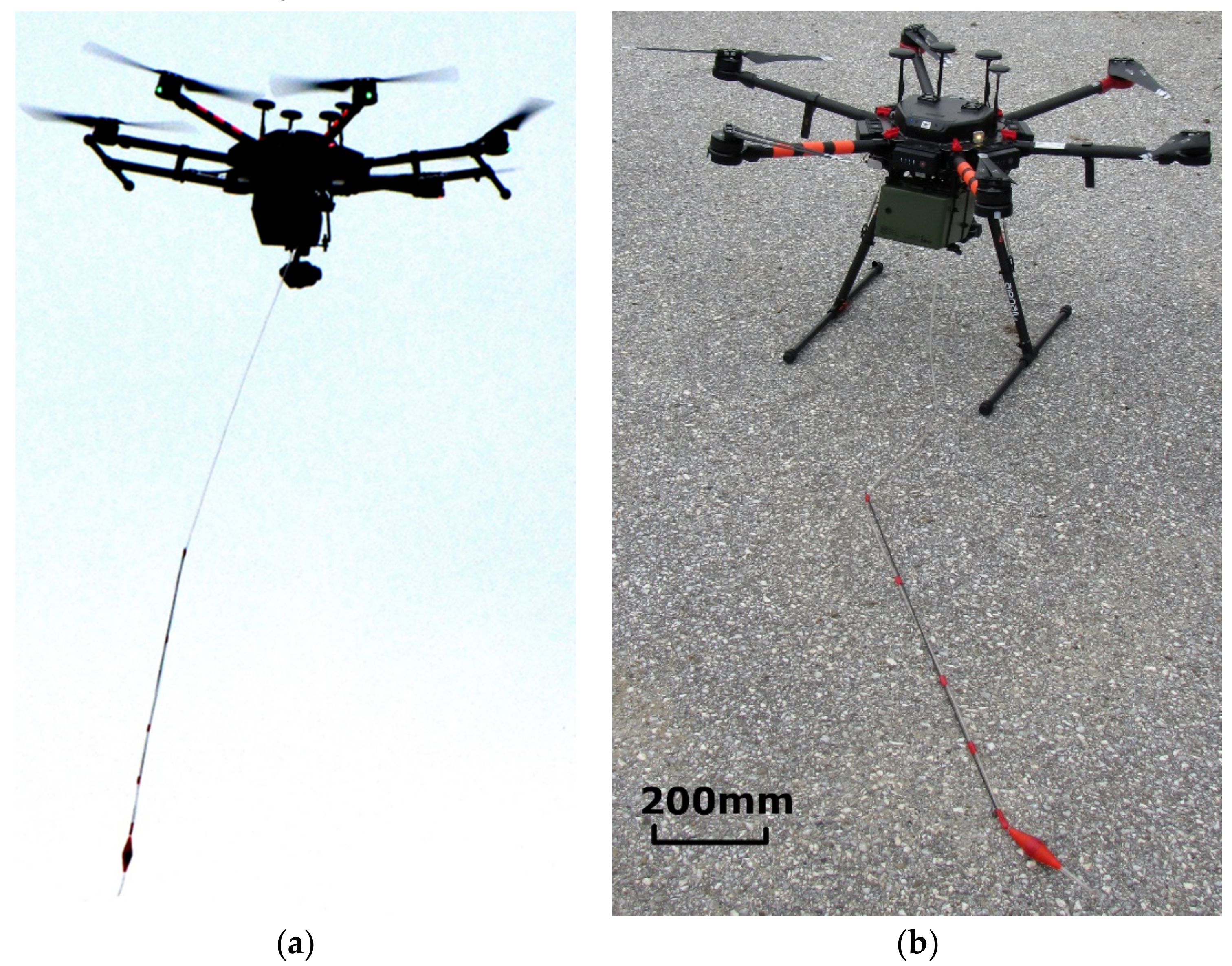
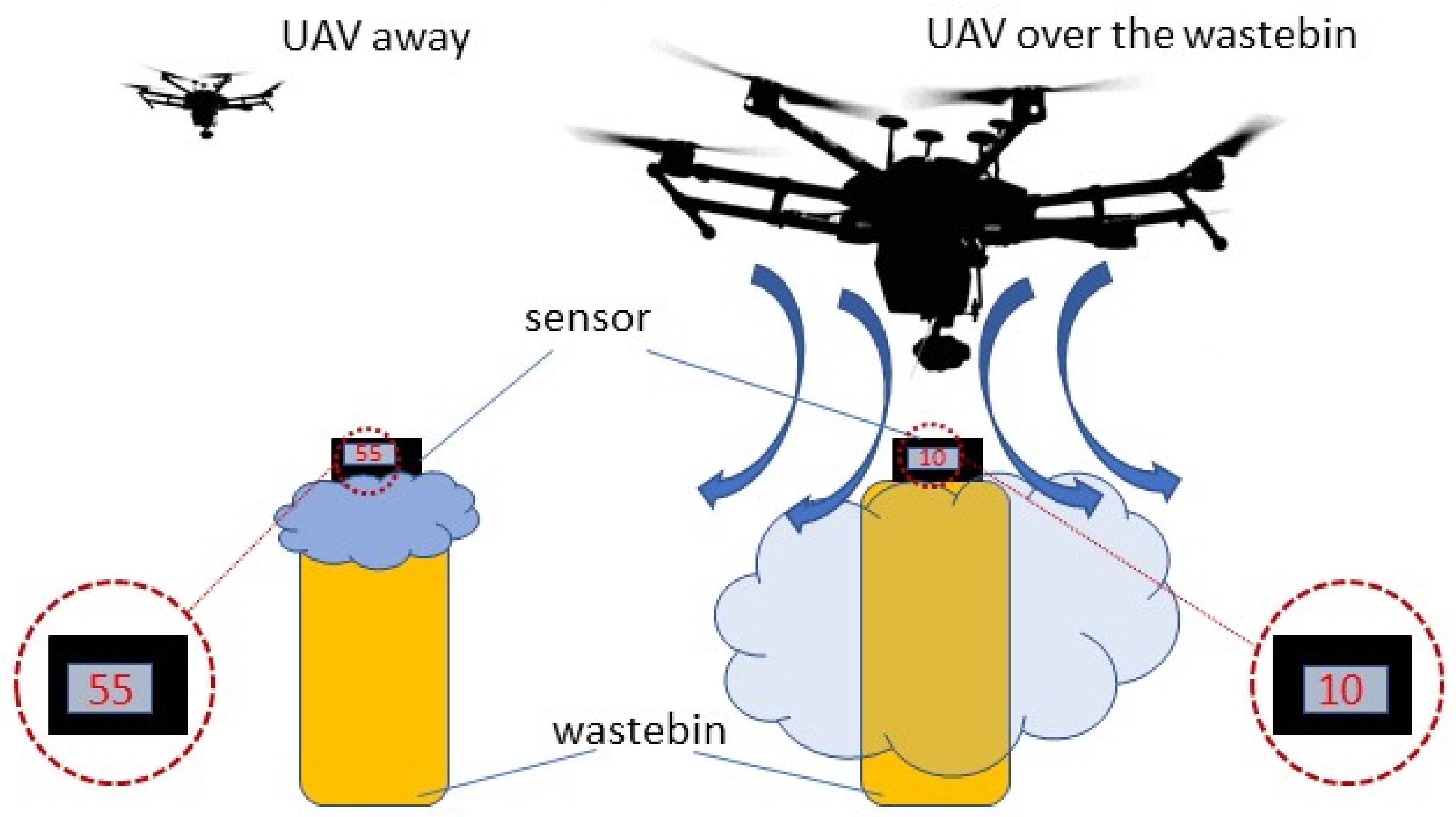
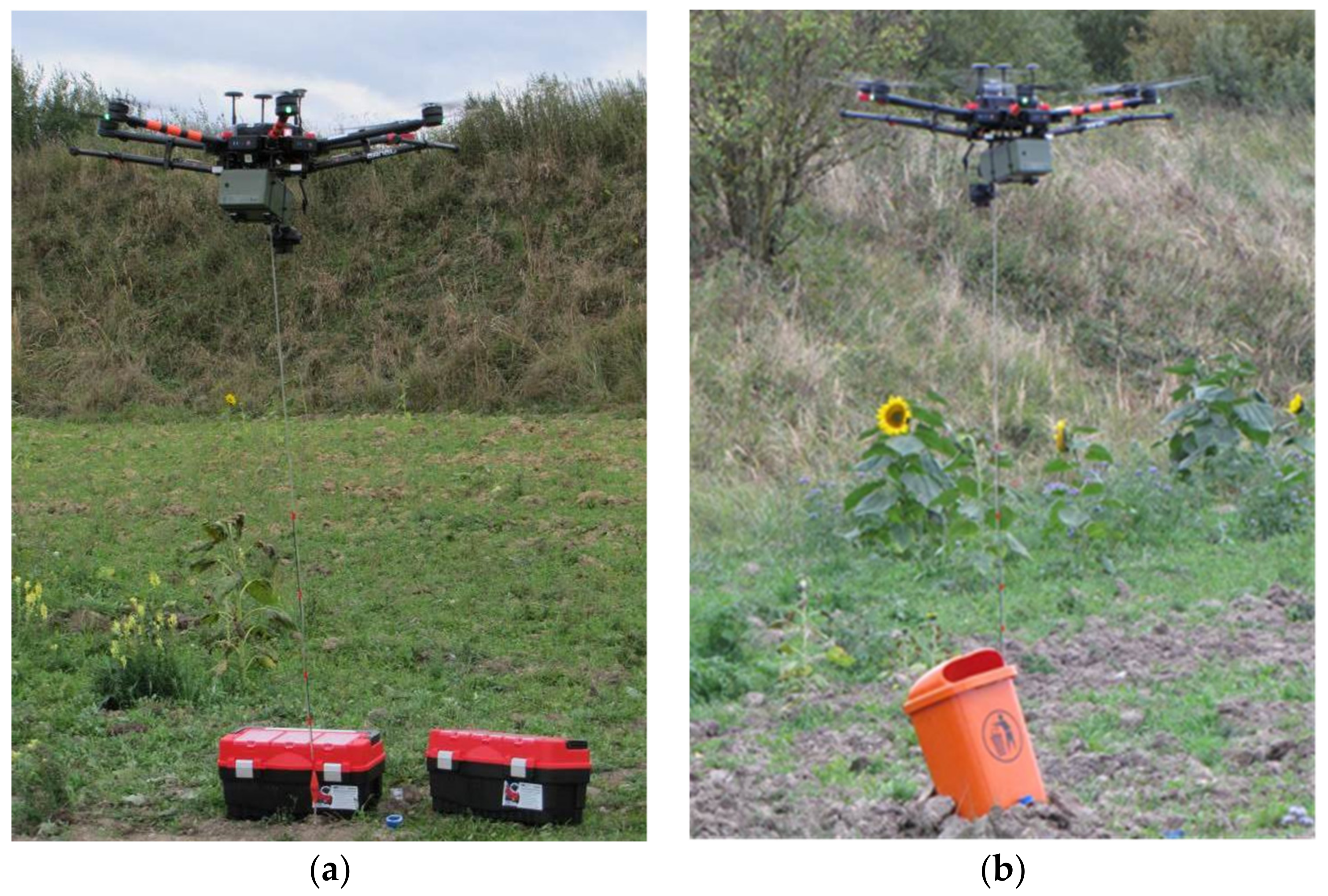
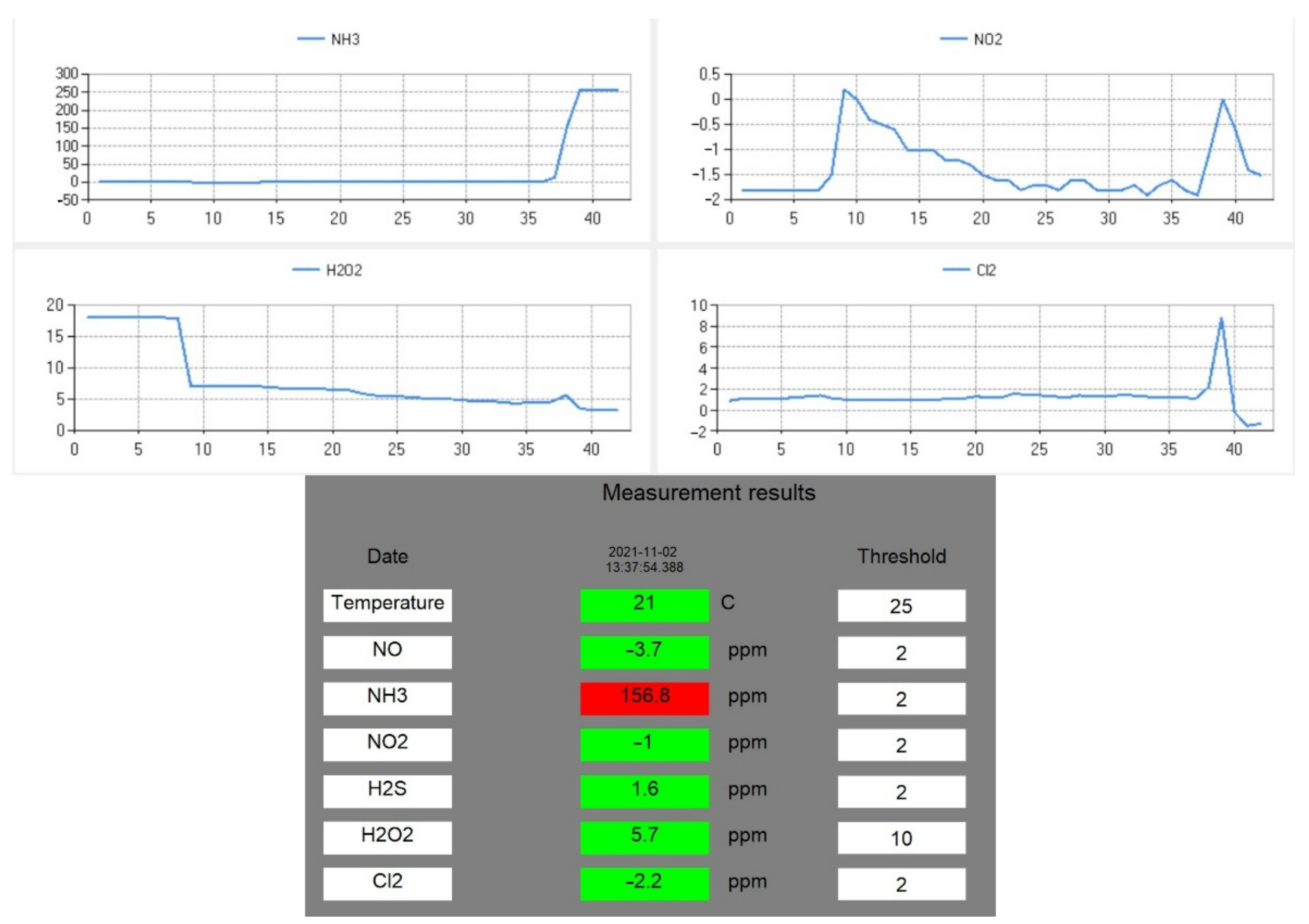
| Dimensions | 240 mm × 160 mm × 120 mm |
| Weight | 1.6 kg with batteries |
| Power supply | Li-Ion battery pack 24 V, 2000 mAh |
| Power consumption | 7.2 W (4–5 h of continuous work) |
| Remote data transmission | About 300 m |
| Number of gas sensor modules | 6 |
| Temperature measurement (MCP9700A) | Internal analog temperature sensor |
| Gas Sensor | Measurement Range (ppm) | Resolution (ppm) | Maximum Overload (ppm) | Output Signal (nA/ppm) | Applied Bias VS-VR (mV) | Response Time (s) |
|---|---|---|---|---|---|---|
| Cl2 | 0–20 | 0.1 | 200 | −900 ± 250 | 0 | <60 |
| NO2 | 0–20 | <0.05 | 200 | −1100 ± 300 | 0 | <60 |
| NO | 0–25 | <0.05 | 50 | 2000 ± 400 | +300 | <10 |
| NH3 | 0–50 | 0.5 | 100 | 155 ± 30 | 0 | <50 |
| H2O2 | 0–100 | <0.05 | 200 | 1100 ± 300 | +300 | <60 |
| H2S | 0–50 | <0.03 | 100 | 1700 ± 300 | 0 | <35 |
Publisher’s Note: MDPI stays neutral with regard to jurisdictional claims in published maps and institutional affiliations. |
© 2021 by the authors. Licensee MDPI, Basel, Switzerland. This article is an open access article distributed under the terms and conditions of the Creative Commons Attribution (CC BY) license (https://creativecommons.org/licenses/by/4.0/).
Share and Cite
Kaliszewski, M.; Włodarski, M.; Młyńczak, J.; Jankiewicz, B.; Auer, L.; Bartosewicz, B.; Liszewska, M.; Budner, B.; Szala, M.; Schneider, B.; et al. The Multi-Gas Sensor for Remote UAV and UGV Missions—Development and Tests. Sensors 2021, 21, 7608. https://doi.org/10.3390/s21227608
Kaliszewski M, Włodarski M, Młyńczak J, Jankiewicz B, Auer L, Bartosewicz B, Liszewska M, Budner B, Szala M, Schneider B, et al. The Multi-Gas Sensor for Remote UAV and UGV Missions—Development and Tests. Sensors. 2021; 21(22):7608. https://doi.org/10.3390/s21227608
Chicago/Turabian StyleKaliszewski, Miron, Maksymilian Włodarski, Jarosław Młyńczak, Bartłomiej Jankiewicz, Lukas Auer, Bartosz Bartosewicz, Malwina Liszewska, Bogusław Budner, Mateusz Szala, Bernhard Schneider, and et al. 2021. "The Multi-Gas Sensor for Remote UAV and UGV Missions—Development and Tests" Sensors 21, no. 22: 7608. https://doi.org/10.3390/s21227608
APA StyleKaliszewski, M., Włodarski, M., Młyńczak, J., Jankiewicz, B., Auer, L., Bartosewicz, B., Liszewska, M., Budner, B., Szala, M., Schneider, B., Povoden, G., & Kopczyński, K. (2021). The Multi-Gas Sensor for Remote UAV and UGV Missions—Development and Tests. Sensors, 21(22), 7608. https://doi.org/10.3390/s21227608






